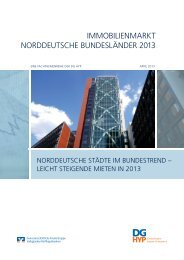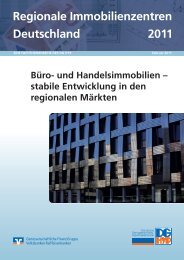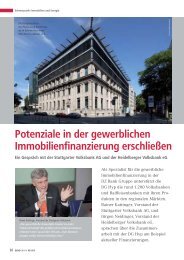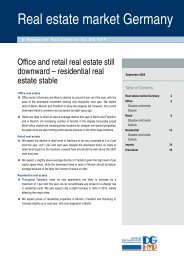ANNUAL REPORT 2006 - DG Hyp
ANNUAL REPORT 2006 - DG Hyp
ANNUAL REPORT 2006 - DG Hyp
Create successful ePaper yourself
Turn your PDF publications into a flip-book with our unique Google optimized e-Paper software.
II) Counterparty risk<br />
Counterparty risk denotes the risk that a business<br />
partner has defaulted on a major liability for more than<br />
90 days, or can only partially repay liabilities, or not at all,<br />
without activities having to be implemented such as<br />
exploiting collateral. Due to the particular relevance of real<br />
estate lending as <strong>DG</strong> HYP’s core business, credit risk is at<br />
the forefront of our observations. The management of<br />
credit risk is conducted largely as follows:<br />
• rating and portfolio-oriented management of new business<br />
and loan extensions;<br />
• credit pricing that is in line with the associated risks;<br />
• active portfolio management (constant portfolio monitoring<br />
and management);<br />
• active management of problem loans (early warning<br />
process, intensified handling, restructuring and settlement).<br />
• annual review of credit risk strategy.<br />
a) Lending process<br />
The lending process for high-volume/smaller-sized retail<br />
business is based on a largely standardised application<br />
scoring system that corresponds to the requirements of<br />
MaRisk as well as to the Basel II regulations. Processing for<br />
this lending business is outsourced to VR Kreditwerk,<br />
observing the provisions of Section 25a of the KWG.<br />
Depending on the relevant score, incoming loan applications<br />
up to € 400,000 are either approved automatically,<br />
approved or rejected on the basis of a separate manual<br />
review within <strong>DG</strong> HYP, or are automatically rejected. In the<br />
retail lending business, lending decisions for loans exceeding<br />
€ 400,000 are always based on a manual review, as<br />
well as on a scoring model. <strong>DG</strong> HYP carries out the entire<br />
loan processing for retail loans of between € 500,000 and<br />
€ 1,000,000.<br />
The loan application process for high-volume retail<br />
lending business was fundamentally reworked and modified<br />
during the <strong>2006</strong> financial year, in cooperation with<br />
VR Kreditwerk. The changes made are geared to reducing<br />
processing time, increasing the quality of decisions and<br />
significantly improving service.<br />
36 Deutsche Genossenschafts-<strong>Hyp</strong>othekenbank AG | Annual Report <strong>2006</strong><br />
Management Report<br />
The front and back offices for commercial real estate<br />
finance are located in <strong>DG</strong> HYP’s Real Estate Centres. Key<br />
workflow stages include the credit rating, which is identified<br />
using rating systems that comply with Basel II, and also<br />
property and project assessments. In the latter case,<br />
<strong>DG</strong> HYP benefits from the proximity of its Real Estate<br />
Centres and surveyors – who are also decentralized – to its<br />
customers. Each lending decision requires a separate vote<br />
by the market unit as well as by the back-office unit. The<br />
loan application is authorised on the basis of lending volume<br />
and risk classification. The corresponding parameters<br />
are laid down in the credit and portfolio strategies.<br />
The credit workflow for Credit Treasury includes processing<br />
new commitments and portfolios, including analysis,<br />
credit decisions, portfolio monitoring and regular<br />
reporting on real estate lending portfolios for RMBS, CMBS<br />
as well as true buy and synthetic transactions. In addition,<br />
structured credit financing is also processed, to the extent<br />
that the item financed is large real estate financing.<br />
b) Limit system<br />
<strong>DG</strong> HYP has a limit system in place to manage and<br />
monitor counterparty and country risks. This system calculates<br />
the utilisation of external limits (country risk limits in<br />
the DZ BANK Group, and default risks in accordance with<br />
section 13 of the KWG), setting internal limits for country<br />
and default risks simultaneously and independently of one<br />
another. The respective limits must be upheld and can be<br />
viewed at any time via an online system.<br />
During the back-office monitoring processes, the<br />
utilisation of the individual limits is monitored daily, and<br />
these are escalated if the limits are exceeded. As part of<br />
this escalation, support is provided to ensure that the limit<br />
is returned to, and that suitable measures are implemented.<br />
Internal individual risk limits are identified depending<br />
on the individual counterparty risk of the business partner.<br />
Limits are issued for banks and states, based on the<br />
corresponding VR rating method established within the<br />
cooperative banking sector.














